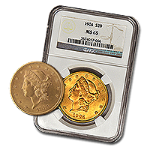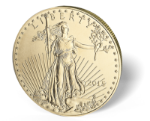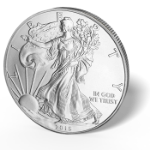Q: Why should I invest in gold and silver?
A: Gold and silver have stood the test of time. They are both considered to be monetary metals that have always held their value. Precious metals protect your assets during times of inflation, economic crises as well as other types of instability. During precious metals bull market periods gold and silver have the ability to outpace inflation creating an opportunity of investment.
As of this writing (April 2012) from January of 2000 to present gold has increased from $255/oz. to $1,650/oz. a gain of 545%. During this same time silver increased from $5.34/oz. to $31.55/oz. a gain of 490%. Inflation during this period has garnered a loss in the U.S. dollar of more than 33%, which would take roughly a 50% investment gain to make up for that loss.
Q: Which type of precious metal should I buy?
A: Both. A diversified portfolio is recommended by most financial advisors and experts alike. Silver tends to be more volatile than gold, therefore you must be able to stomach the day-to-day fluctuations and sometimes wild swings.
Many times you will hear precious metals analysts talk of the gold/silver ratio. Historically the price of silver has trended at around 16 to 1; meaning if gold’s value is at $1,650/oz. silver should be around $103/oz. With silver prices around $31 experts are calling silver undervalued.
Q: What are pre-1933 gold coins and why should I own them?
A: Pre-1933 gold coins were minted in the U.S. between 1795 and 1933 and are coveted by collectors and investors alike. Owning pre-1933 gold coins adds diversity to your portfolio and gives you a slightly different exposure to the gold market.
We currently offer the Liberty Head and Saint Gaudens series of coins in common dates only. Common date gold coins in low grades tend to perform like bullion gold (spot price) while higher grade coins i.e. MS64-MS65 will be less affected by spot price fluctuations.
There always exists a spread between bullion prices and pre-1933 gold coins. Sometimes these spreads are low, 5%, and sometimes the spreads can be high, 50%. Investors look for times when the prices of pre-1933 common date gold coins are close to the spot price to take advantage of premium plays, in the hopes of selling them at a profit when the spreads are closer to 50%.
Q: What is the spot price?
A: The spot price of gold is the cost per ounce of 100oz contracts in raw form (unrefined) for immediate delivery. Not to be confused with the futures price of gold which assumes delivery sometime out in the future and carries with it finance and storage charges.
Q: Why can’t I buy gold at the spot price?
A: The spot price of gold or silver is an indicator price for the physical metals markets. For gold that has been refined or minted into coins or bars there is a premium above the spot price. This premium can vary depending on the coin or bar. For example due to high demand for the gold American Eagle it typically carries the highest premium over spot. The US Mint might buy thousands of ounces of gold at the spot price and will then manufacture the gold into coins and sell them to a distributor. The distributor will mark them up and sell them to a retailer which will market the coins to the public.
Q: What does PCGS and NGC graded mean?
A: Professional Coin Grading Service (PCGS) and Numismatic Guaranty Corporation (NGC) are the leading independent coin grading services whose standards are accepted throughout the numismatic industry. When purchasing graded coins, you should only buy coins that are graded by PCGS or NGC. They offer protection for investors and collectors by guaranteeing the grades of the coins which they certify and also virtually eliminate the possibility of counterfeiting.
Q: Should I buy physical gold and silver or ETF’s?
A: Chances are that your financial advisor will recommend that you buy ETF’s (electronically traded funds) like GLD or SLV because that is what they can sell you. If you look closely at ETF’s chances are that you will find higher costs and greater risks than owning physical gold or silver. One advantage to ETF’s is you can trade in and out very quickly; therefore they are great vehicles for day traders. Physical metal has no counterparty risk and low fees to buy and sell. If you are looking for a stable long-term investment physical metal is the way to go. If you are looking for a short-term trading vehicle, ETF’s are probably a good choice for you.
Everything you acquire from us is the physical metal. We will ship it to you and you can determine where you would like to store it. We do not offer ETF’s of gold certificates of any kind.
Q: Will gold and silver go up in value?
A: We are currently experiencing a bull market in gold and silver; therefore the chances are likely that we will see prices rise in the future, however there are no guarantees. History tells us that bull markets all end in a widely speculative panic phase in which prices rise quickly to unsustainable values (aka bubble). We believe this will happen to gold and silver sometime in the future.
Many experts are predicting that gold and silver will rise well into the future. We have seen gold predictions as high as $11,000 per ounce and silver predictions as high as $700 per ounce.











